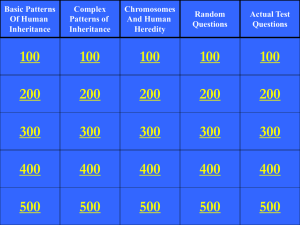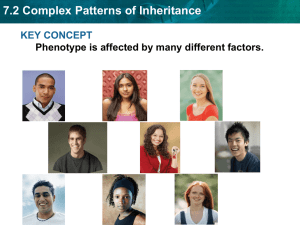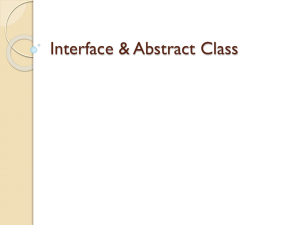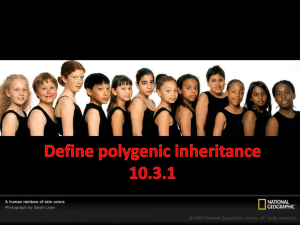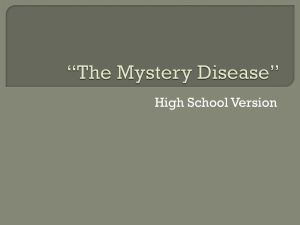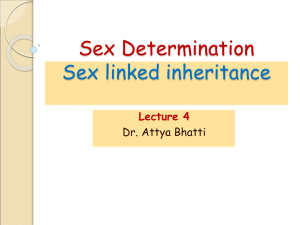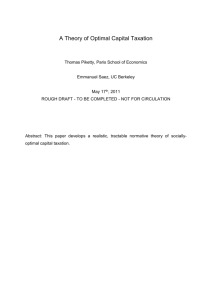Chapter 12
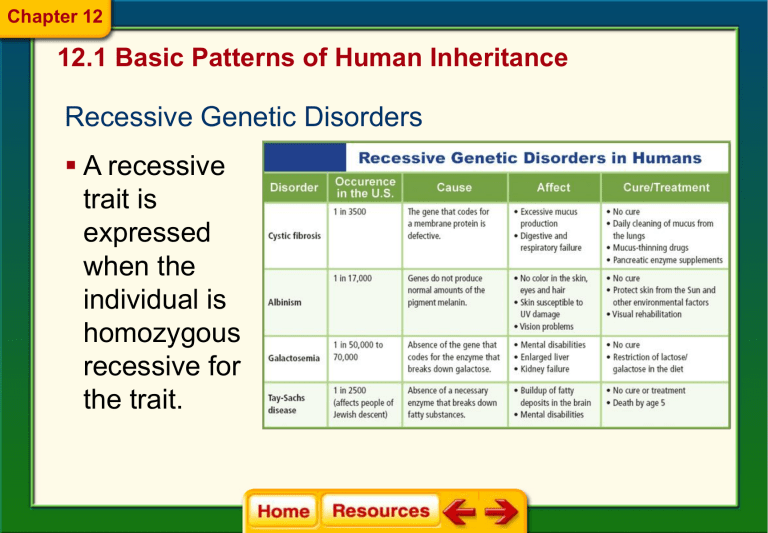
Chapter 12
12.1 Basic Patterns of Human Inheritance
Recessive Genetic Disorders
A recessive trait is expressed when the individual is homozygous recessive for the trait.
Chapter 12
12.1 Basic Patterns of Human Inheritance
Cystic Fibrosis
Affects the mucus-producing glands, digestive enzymes, and sweat glands
Chloride ions are not absorbed into the cells of a person with cystic fibrosis but are excreted in the sweat.
Without sufficient chloride ions in the cells, a thick mucus is secreted.
Chapter 12
12.1 Basic Patterns of Human Inheritance
Albinism
Caused by altered genes, resulting in the absence of the skin pigment melanin in hair and eyes
White hair
Very pale skin
Pink pupils
Chapter 12
12.1 Basic Patterns of Human Inheritance
Tay-Sachs Disease
Caused by the absence of the enzymes responsible for breaking down fatty acids called gangliosides
Gangliosides accumulate in the brain, inflating brain nerve cells and causing mental deterioration.
12.1 Basic Patterns of Human Inheritance
Galactosemia
Recessive genetic disorder characterized by the inability of the body to digest galactose.
Chapter 12
12.1 Basic Patterns of Human Inheritance
Dominant Genetic Disorders
Huntington’s disease affects the nervous system.
Achondroplasia is a genetic condition that causes small body size and limbs that are comparatively short.
Chapter 12
12.1 Basic Patterns of Human Inheritance
Chapter 12
12.1 Basic Patterns of Human Inheritance
Pedigrees
A diagram that traces the inheritance of a particular trait through several generations
Chapter 12
12.1 Basic Patterns of Human Inheritance
Inferring Genotypes
Knowing physical traits can determine what genes an individual is most likely to have.
Predicting Disorders
Record keeping helps scientists use pedigree analysis to study inheritance patterns, determine phenotypes, and ascertain genotypes.
Chapter 12
12.2 Complex Patterns of Inheritance
Incomplete Dominance
The heterozygous phenotype is an intermediate phenotype between the two homozygous phenotypes. (both alleles are blended)
Chapter 12
12.2 Complex Patterns of Inheritance
Codominance
Both alleles are expressed in the heterozygous condition. (both alleles are seen at the same time)
Chapter 12
12.2 Complex Patterns of Inheritance
Sickle-cell Disease
Changes in hemoglobin cause red blood cells to change to a sickle shape.
People who are heterozygous for the trait have both normal and sickle-shaped cells.
Sickle cell
Normal red blood cell
7766x
Chapter 12
12.2 Complex Patterns of Inheritance
Multiple Alleles
Blood groups in humans
ABO blood groups have three forms of alleles.
Chapter 12
12.2 Complex Patterns of Inheritance
Coat Color of Rabbits
Multiple alleles can demonstrate a hierarchy of dominance.
In rabbits, four alleles code for coat color:
C , c ch
, c h
, and c .
Chapter 12
12.2 Complex Patterns of Inheritance
Coat Color of Rabbits
Chinchilla
Light gray
Albino
Dark gray Himalayan
Chapter 12
12.2 Complex Patterns of Inheritance
Epistasis
Variety is the result of one allele hiding the effects of another allele. eebb eeB_
No dark pigment present in fur
E_bb E_B_
Dark pigment present in fur
Chapter 12
12.2 Complex Patterns of Inheritance
Sex Determination
Sex chromosomes determine an individual’s gender.
Chapter 12
12.2 Complex Patterns of Inheritance
Sex-Linked Traits
Genes located on the X chromosome
Red-green color blindness
Hemophilia
Chapter 12
12.2 Complex Patterns of Inheritance
Polygenic Traits
Polygenic traits arise from the interaction of multiple pairs of genes.
Chapter 12
12.2 Complex Patterns of Inheritance
Environmental Influences
Environmental factors
Diet and exercise
Sunlight and water
Temperature
Chapter 12
12.2 Complex Patterns of Inheritance
Twin Studies
Helps scientists separate genetic contributions from environmental contributions
Traits that appear frequently in identical twins are at least partially controlled by heredity.
Traits expressed differently in identical twins are strongly influenced by environment.
Chapter 12
12.3 Chromosomes and Human Heredity
Karyotype Studies
Karyotype —micrograph in which the pairs of homologous chromosomes are arranged in decreasing size.
Images of chromosomes stained during metaphase
Chromosomes are arranged in decreasing size to produce a micrograph.
